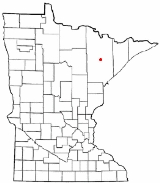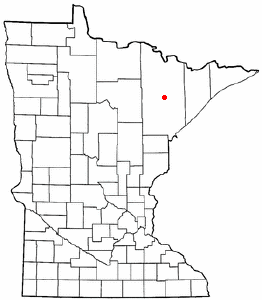
McKinley, St. Louis County, Minnesota
Encyclopedia
McKinley is a city in Saint Louis County
, Minnesota
, United States
. The population was 128 at the 2010 census.
State Highway 135
serves as a main arterial route in the community.
 According to the United States Census Bureau
According to the United States Census Bureau
, the city has a total area of 0.8 square miles (2.1 km²), of which, 0.8 square miles (2.0 km²) of it is land and 0.04 square miles (0.1 km²) of it (3.75%) is water.
of 2000, there were 80 people, 37 households, and 25 families residing in the city. The population density
was 103.3 people per square mile (40.1/km²). There were 43 housing units at an average density of 55.5 per square mile (21.6/km²). The racial makeup of the city was 97.50% White, and 2.50% from two or more races. 28.6% were of Slovene, 14.3% German
, 11.9% English
, 9.5% Norwegian
and 7.1% Austrian
ancestry according to Census 2000.
There were 37 households out of which 24.3% had children under the age of 18 living with them, 62.2% were married couples
living together, 2.7% had a female householder with no husband present, and 32.4% were non-families. 32.4% of all households were made up of individuals and 16.2% had someone living alone who was 65 years of age or older. The average household size was 2.16 and the average family size was 2.68.
In the city the population was spread out with 20.0% under the age of 18, 6.3% from 18 to 24, 28.8% from 25 to 44, 16.3% from 45 to 64, and 28.8% who were 65 years of age or older. The median age was 43 years. For every 100 females there were 110.5 males. For every 100 females age 18 and over, there were 93.9 males.
The median income for a household in the city was $28,750, and the median income for a family was $48,750. Males had a median income of $36,250 versus $20,313 for females. The per capita income
for the city was $14,384. There were 16.7% of families and 30.5% of the population living below the poverty line, including 80.0% of under eighteens and none of those over 64.
St. Louis County, Minnesota
St. Louis County is a county located in the U.S. state of Minnesota. As of 2010, the population was 200,226. Its county seat is Duluth. It is the largest county by total area in Minnesota, and the second largest in the United States east of the Mississippi River; in land area alone, after Aroostook...
, Minnesota
Minnesota
Minnesota is a U.S. state located in the Midwestern United States. The twelfth largest state of the U.S., it is the twenty-first most populous, with 5.3 million residents. Minnesota was carved out of the eastern half of the Minnesota Territory and admitted to the Union as the thirty-second state...
, United States
United States
The United States of America is a federal constitutional republic comprising fifty states and a federal district...
. The population was 128 at the 2010 census.
State Highway 135
Minnesota State Highway 135
Minnesota State Highway 135 is a highway in northeast Minnesota, which runs from its interchange with U.S. Highway 53 in the city of Virginia and continues northeast to its northern terminus at its intersection with State Highway 1 in Tower....
serves as a main arterial route in the community.
Geography

United States Census Bureau
The United States Census Bureau is the government agency that is responsible for the United States Census. It also gathers other national demographic and economic data...
, the city has a total area of 0.8 square miles (2.1 km²), of which, 0.8 square miles (2.0 km²) of it is land and 0.04 square miles (0.1 km²) of it (3.75%) is water.
Demographics
As of the censusCensus
A census is the procedure of systematically acquiring and recording information about the members of a given population. It is a regularly occurring and official count of a particular population. The term is used mostly in connection with national population and housing censuses; other common...
of 2000, there were 80 people, 37 households, and 25 families residing in the city. The population density
Population density
Population density is a measurement of population per unit area or unit volume. It is frequently applied to living organisms, and particularly to humans...
was 103.3 people per square mile (40.1/km²). There were 43 housing units at an average density of 55.5 per square mile (21.6/km²). The racial makeup of the city was 97.50% White, and 2.50% from two or more races. 28.6% were of Slovene, 14.3% German
Germans
The Germans are a Germanic ethnic group native to Central Europe. The English term Germans has referred to the German-speaking population of the Holy Roman Empire since the Late Middle Ages....
, 11.9% English
English people
The English are a nation and ethnic group native to England, who speak English. The English identity is of early mediaeval origin, when they were known in Old English as the Anglecynn. England is now a country of the United Kingdom, and the majority of English people in England are British Citizens...
, 9.5% Norwegian
Norwegians
Norwegians constitute both a nation and an ethnic group native to Norway. They share a common culture and speak the Norwegian language. Norwegian people and their descendants are found in migrant communities worldwide, notably in United States, Canada and Brazil.-History:Towards the end of the 3rd...
and 7.1% Austrian
Austrians
Austrians are a nation and ethnic group, consisting of the population of the Republic of Austria and its historical predecessor states who share a common Austrian culture and Austrian descent....
ancestry according to Census 2000.
There were 37 households out of which 24.3% had children under the age of 18 living with them, 62.2% were married couples
Marriage
Marriage is a social union or legal contract between people that creates kinship. It is an institution in which interpersonal relationships, usually intimate and sexual, are acknowledged in a variety of ways, depending on the culture or subculture in which it is found...
living together, 2.7% had a female householder with no husband present, and 32.4% were non-families. 32.4% of all households were made up of individuals and 16.2% had someone living alone who was 65 years of age or older. The average household size was 2.16 and the average family size was 2.68.
In the city the population was spread out with 20.0% under the age of 18, 6.3% from 18 to 24, 28.8% from 25 to 44, 16.3% from 45 to 64, and 28.8% who were 65 years of age or older. The median age was 43 years. For every 100 females there were 110.5 males. For every 100 females age 18 and over, there were 93.9 males.
The median income for a household in the city was $28,750, and the median income for a family was $48,750. Males had a median income of $36,250 versus $20,313 for females. The per capita income
Per capita income
Per capita income or income per person is a measure of mean income within an economic aggregate, such as a country or city. It is calculated by taking a measure of all sources of income in the aggregate and dividing it by the total population...
for the city was $14,384. There were 16.7% of families and 30.5% of the population living below the poverty line, including 80.0% of under eighteens and none of those over 64.

